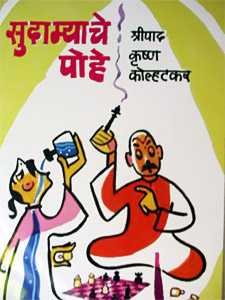 Shripad Krishna Kolhatkar was born in Buldana in 1871. He was educated as a lawyer in Bombay. He acted in a translation of Sudraka`s Mricchakatika in 1891, while a student of Deccan College, Pune, but began writing in 1893 with a scathing review of Madhavrao Patankar`s popular play, Vikram-Shashikala i.e. `Vikram and Shashikala`. Shripad Krishna Kolhatkar was a fan of Parsi theatre. Especially the songs set to racy rhythmic tunes and the fantastic tales of suspense and wonder. He actually tried to synthesize these elements with his socially progressive ideology in his drama. Reacting against Sangitnatak`s prevalent mythological formula, he wrote twelve plays with original plots. Only the first eight were staged. The names can be mentioned as Viratanaya i.e. `Hero`s Son` in 1896, Mukamyak i.e. `Speechless Protagonist` in 1901, Gupta-manjush i.e. `Secret Box` in 1901, Mativikar i.e. `Disease of Intellect` in 1906, Premshodhan i.e. `Search for Love` in 1910. All were for Kirloskar Natak Mandali, namely Vadhu-pariksha i.e. `Test of the Bride` in 1914, Sahacharini i.e. `Companion` in 1918 and zndjanma-rahasya i.e. `Mystery of Birth` in 1918.
Shripad Krishna Kolhatkar was born in Buldana in 1871. He was educated as a lawyer in Bombay. He acted in a translation of Sudraka`s Mricchakatika in 1891, while a student of Deccan College, Pune, but began writing in 1893 with a scathing review of Madhavrao Patankar`s popular play, Vikram-Shashikala i.e. `Vikram and Shashikala`. Shripad Krishna Kolhatkar was a fan of Parsi theatre. Especially the songs set to racy rhythmic tunes and the fantastic tales of suspense and wonder. He actually tried to synthesize these elements with his socially progressive ideology in his drama. Reacting against Sangitnatak`s prevalent mythological formula, he wrote twelve plays with original plots. Only the first eight were staged. The names can be mentioned as Viratanaya i.e. `Hero`s Son` in 1896, Mukamyak i.e. `Speechless Protagonist` in 1901, Gupta-manjush i.e. `Secret Box` in 1901, Mativikar i.e. `Disease of Intellect` in 1906, Premshodhan i.e. `Search for Love` in 1910. All were for Kirloskar Natak Mandali, namely Vadhu-pariksha i.e. `Test of the Bride` in 1914, Sahacharini i.e. `Companion` in 1918 and zndjanma-rahasya i.e. `Mystery of Birth` in 1918.
These unconventional works dealt with such topics as women`s education, love marriages, abortion, divorce, widow marriage, and the caste system. Their complicated yet well-organized plots amply used disguise, mystery, and suspense, interspersed with innovative, catchy songs that Kolhatkar composed. The witty dialogue, irony, and puns enhanced the entertainment value. They required a realistic style of presentation, but their supernaturalism does not seem to root their world in life, probably denying them long runs. Still, the spirit of experimentation reflected in the combination of realism and fantasy exerted considerable influence on future playwrights of Marathi theatre. Kolhatkar`s articles in Sudamyache pohe i.e. `Sudama`s Rice Flakes` established humour as a Marathi literary genre. He wrote two novels and a collection of poems. He was seriously interested in astrology and mathematics, and for this he published a book titled Bharatiya jyotirganita i.e. `Indian Astrology` in 1913.
This article is a stub. You can enrich by adding more information to it. Send your Write Up to [email protected]




















